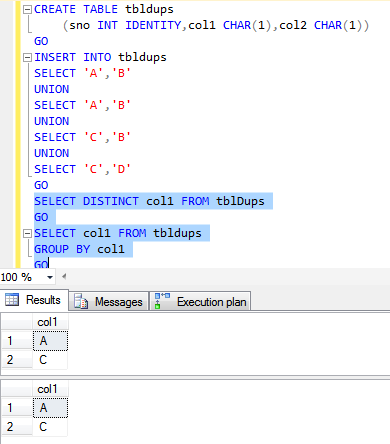Customers as C where exists. SQL Server Developer Center. Left Join with Distinct Clause - Stack. Nach SQL -Standard hingegen sind beide nicht äquivalent. Hi SQL _Gun, Your first join will get a result as below.
The following statement retrieves the salary data from the employees table and sorts it in descending order. For the demonstration, we will use the customers table from the sample database. Why do you want to use JOIN and distinct ? Hi again, I have this SQL (part of a stored procedure) where I do LEFT JOIN. SELECT callingPartyNumber, AlertingName, originalCalledPartyNumber.
OUTER JOIN wird im nächsten Kapitel behandelt. DISTINCT for multiple columns is not supported. Vorteil: einfach zu nutzen, z. Quantity AS Quantity, P. Abfragen (nested selects). ProductName AS Product, Orders.
For example, in the customers table, we have many rows whose state column has NULL values. Learn How to Combine Data with a CROSS JOIN A cross join is used when you wish to create combination of every row from two tables. Ich habe eine harte Zeit wie folgt: select a. For example, several employees listed in an Employees table may have the same last name. Dies leistet die JOIN -Verknüpfung. Ein JOIN fügt zwei Tabellen zu einer neuen, virtuellen Tabelle zusammen, die anschließend mit einem weiteren JOIN sowie der nächsten Tabelle verknüpft werden kann.
Folglich genügt es, einen JOIN zwischen zwei Tabellen zu behandeln. Complete guide on SQL Distinct : find out how to select Distinct in SQL with ease and discover Distinct SQL examples with this SQL Distinct guide. SQL Joins Using WHERE or ON.

Within the WHERE clause lies many possibilities for modifying your SQL statement. Here are some examples of how to use these in your SQL statements. The SQL Distinct command can be used in the SELECT statement to ensure that the query returns only distinct (unique) rows. When the query is selecting the rows it discards any row which is a duplicate of any other row already selected by the query.
Rein nach SQL ist es so richtig - ergo muss ich mir die Daten genauer aunschauen. It doesn’t matter whether you introduce duplicates with a join or not. Distinct is ran on the selected columns after records are found (all joins are evaluated and columns are retrieved), so when using distinct it should not be possible to get duplicates (across all columns), no matter what you do.
The inner join clause allows you to query data from two or more related tables. A JOIN locates related column values in the two tables. A query can contain zero, one, or multiple JOIN operations. A resource explaining what a SQL join is, examples of different join types, and the technical ETL documentation required to start joining tables. In den weiteren Teilen werden spezifische Aspekte der Sprache definiert.
INNER JOIN coursetypes ON coursetypes. In a table, there may be a chance to exist a duplicate value and sometimes we want to retrieve only unique values. Run the SQL and view the result.
Type the following SQL statement. I want to find sum of qtyfrom orders for each CartonCode and at the same time I want to do outer join with cartoncodes to find loosecode of cartoncode from Orders table if any otherwise null. Doch es gibt noch weitere JOIN -Typen die im folgenden behandelt werden. Its usage was typical for the triggered incidents scope, which involved finding incidents with zero acknowledgements. There is a big problem with LEFT JOIN.
Can you think what it is? If not, ask yourself what’s the most confusing thing about SQL ? That’s right, it’s NULL. People don’t understand NULL, and even people who do understand it have trouble with it, because it’s ugly and nasty and illogical.

Working left join WorkingCategory on Working.
Keine Kommentare:
Kommentar veröffentlichen
Hinweis: Nur ein Mitglied dieses Blogs kann Kommentare posten.